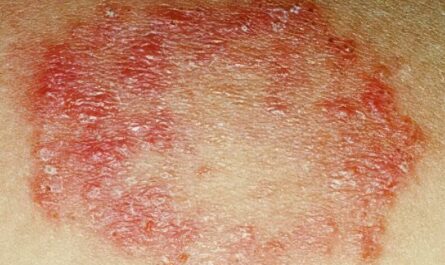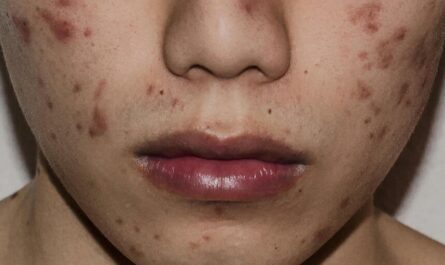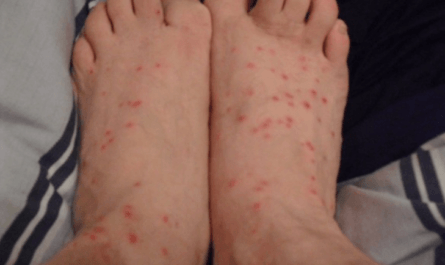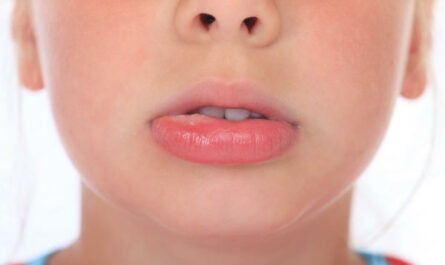Rash on the face is a common condition that can occur in all age groups and all people. This condition is usually an inflammation of the facial skin. Facial rashes can cause dry skin, redness, scaling, itching, blistering, and even bleeding.
Depending on the location and severity, the appearance of the facial rash will vary. For example, it can be white, purple, silver, or red. The texture of the rash can be raised, flat, or scaly. In addition, the facial rash may be spotty or continuous and large.
In most cases, facial rashes may be caused by skin infections, irritation, or inflammation. Common causes include dermatitis, acne, mild allergic reactions, and inflammatory diseases. However, in some cases, the facial rash may also warn of other physical problems, such as systemic lupus erythematosus.
If you experience other physical symptoms such as fever, stiff neck, or shortness of breath, you must seek medical care immediately, as this may be life-threatening. This article will discuss 13 common causes of facial rashes and treatments.
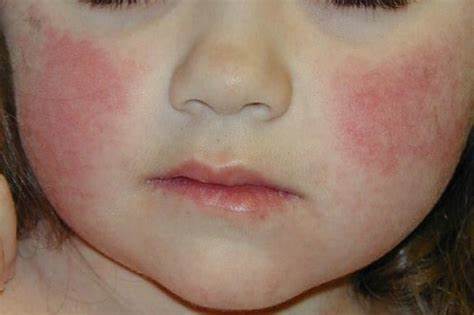
What is the rash?
A rash is a skin irritation marked by reddened, raised, and sometimes itchy patches on the skin. Rashes can be caused by various factors, including allergies, infections, and other skin conditions. Sometimes, a rash may result from a serious underlying medical condition.
Rashes can range from mild to severe and can appear anywhere on the body. The skin may be red and itchy or scaly and dry. In some cases, blisters or bumps may appear. Certain rashes may cause fever, chills, or pain.
13 Common Causes of Rash on the Face with Treatment
There are many reasons for facial rashes. Usually, hormonal changes in the body or some environmental factors may cause the rash. The following is a list of the most likely causes of skin rash.
1. Psoriasis Psoriasis
Psoriasis Psoriasis is an autoimmune disease, which is one of the common causes of facial rashes. According to statistics, it affects more than 46% of the world’s population. Psoriasis causes an increase in the growth cycle of skin cells, and it may appear on the face and body simultaneously.
Psoriasis can cause itchy facial skin and silver dander. It often appears around the forehead and eyebrows, the skin above the lips, and the area near the hairline. In most cases, it looks like raised red spots are covered with dead skin cells. Sometimes psoriasis is also related to arthritis.
To get rid of Psoriasis Psoriasis, you need to consult your dermatologist for help. Doctors usually treat psoriasis with oral medications or topical ointments.
2. Infection
A rash on the face can be caused by an infection. Infections that can cause this type of rash include bacterial infections, viral infections, and fungal infections.
Bacterial infections include strep throat, impetigo, and cellulitis. Viral infections include the common cold, measles, and chickenpox. Fungal infections like ringworm, athlete’s foot, and jock itch can also cause a facial rash.
The symptoms of a facial rash caused by an infection can vary depending on the type of infection. Common symptoms include redness, itchiness, swelling, and bumps. In some cases, the rash may also be accompanied by fever and other flu–like symptoms.
Treatment for a facial rash caused by an infection will depend on the type of infection and the severity of the symptoms.
Antibiotics may be prescribed for bacterial infections, and antiviral medications may be prescribed for viral infections. Fungal infections can usually be treated with antifungal medications. In some cases, the rash may clear up without treatment.
3. Folliculitis
Folliculitis is a rash caused by inflammation or infection of the hair follicles. One type of folliculitis, also called shaving bumps, is caused by an inflammatory reaction to ingrown hairs.
Another type of folliculitis is tinea barbae which is caused by a fungus. Staphylococcal folliculitis is an infection of the hair follicles caused by staphylococcus bacteria. It can lead to white bumps in the beard area.
4. Acne
Acne is one of the most common skin diseases in the United States, especially for adolescent children. This condition occurs when too much oil clogs the skin’s pores, and the growth of bacteria leads to skin inflammation.
Acne often appears on the face, causing redness, swelling, and skin itching. To get rid of acne, you can try antibiotics or natural home remedies. Some natural remedies such as Aloe Vera, Tea Tree Oil, and Lemon Juice can effectively help eliminate facial acne. For more information, you can read this article.
5. Allergies
Itchy and redness on the face is sometimes an allergic reaction of the skin to food or other products. For example, allergic reactions to seafood and some fruits may cause a rash on the face.
Using substandard facial products can cause skin redness and itching. To relieve allergic reactions, you need to get rid of these allergens. If the condition is severe, you need to consult a dermatologist.
6. Heat rash
Heat rash is caused by excessive skin exposure to heat and sunlight. Common symptoms include red pimples on the face and neck. To relieve symptoms, you’d better avoid excessive exposure to heat and sunlight. In addition, you can also apply sunscreen or wear a sun hat.
7. Dry skin
In the autumn and winter seasons, the skin is prone to dryness leading to dryness and itching of the facial skin. Lack of vitamins in the body or using substandard facial products can also cause dry skin.
In addition, some diseases, such as hypothyroidism and diabetes, can also cause dry facial skin. It would help if you went to the hospital for an examination to find the root cause of the problem.
8. Shingles
Shingles are a skin rash caused by the herpes zoster virus, which can also cause chickenpox. This condition can cause a painful, blistering rash and fluid-filled bumps that can occur on any part of the body, including your face. These bumps are usually very painful. Without effective treatment, shingles may permanently damage your eyesight.
Although the rash tends to clear up on its own, treatment is also important. Taking analgesics and antivirals can help eliminate shingles, save your eyesight, and prevent long-term neuralgia.
9. Impetigo rash
Impetigo rash is an infection caused by bacteria entering the skin. According to MayoClinic.com, this is a highly contagious disease that usually appears on children’s faces. Doctors usually treat infections with antibiotic ointments or oral antibiotics. Impetigo usually disappears within a few weeks.
10. Rosacea
Rosacea is a common facial rash that can cause swelling, redness, and itching of the skin. The reason for this situation is still unclear. If left untreated, rosacea can cause psychological problems. Although there is no cure for this condition, antibiotic ointments or oral antibiotics can effectively relieve the symptoms.
11. Dermatitis
There are many types of dermatitis. Atopic dermatitis, also called eczema, can cause a rash, redness, and itching of facial skin. This rash often appears on babies’ cheeks, causing dry, scaly, and itchy skin.
Seborrheic dermatitis is a common skin condition that can cause a red rash, scaling, or flaking. The rash may cause the skin to look oily on the face. Seborrheic dermatitis usually requires treatment, including using a dandruff shampoo and medicine to clear it.
Contact dermatitis is a symptom caused by exposure to irritants or allergens. It usually disappears on its own after removing allergens such as ivy or nickel.
12. Lupus
Lupus is an autoimmune disease that causes redness and swelling of the skin. This condition occurs when your body’s immune system mistakenly regards a part of your body as a foreign body and attacks that part.
Lupus causes a rash on the face that looks like a butterfly. This is a serious physical illness, and you need to seek medical help as soon as possible.
13. Reaction to drugs
Certain drugs, such as hydrocortisone cream, can cause a sunburn-like reaction, causing redness and itching. You need to check the medicine instructions to see if you should avoid direct sunlight. If the redness persists long, you can consult your dermatologist.
How to Treat Rashes on the Face?
The facial rash is annoying because it affects the appearance of the face and causes discomfort. There are some measures to speed up recovery and prevent rashes on the face.
- You can use a mixture of olive oil and baking soda or aloe vera to relieve itchy skin.
- Calamine can effectively relieve itching caused by skin rashes, such as chickenpox, ivy, and oak poison.
- Acetaminophen or ibuprofen can reduce the rash caused by mild pain.
- Vitamin E and cod liver oil supplementation and a balanced diet can prevent dry facial skin.
- Wrapping ice cubes in a towel and applying ice compresses can help relieve allergic facial itching.
- Applying cooked oatmeal to the skin can help relieve extreme itching and pain.
- Infections caused by bacteria can be treated with antibiotics. Infections caused by fungi can be treated with antifungal drugs. But be sure to consult a doctor before use.
How to Prevent Rashes on the Face?
- Avoid using harsh soaps and poor-quality products to wash your face, and you can use mild soap for sensitive skin or baby skin.
- Do not use any lotion or cosmetics that may cause rashes. Avoid hot water and direct sunlight to relieve facial psoriasis.
- The topical application of petroleum jelly or moisturizer can help keep the skin moisturized.
- Make sure to consult a dermatologist before taking any medications.
- Avoid foods, skincare products, cosmetics, or medicines that are allergic to you.
- Stay away from poisonous plants such as ivy, oak, and sumac.
- When hiking or working in the woods, wear long-sleeved shirts and trousers to cover bare arms and legs.
When To See a Doctor?
If the following symptoms occur, seek medical attention immediately. These symptoms may be signs of a life-threatening allergic reaction.
- Fever, difficulty breathing, rapid pulse, nausea, or confusion
- Severe skin redness or swelling that lasts for more than a week
- Other symptoms include cough, headache, stuffy nose, or sore throat
- Fatigue, joint swelling, muscle aches, unexplained weight loss
There are many reasons for a rash on the face. Some skin rashes caused by viruses will disappear within a few days without medication. However, a rash caused by allergic reactions may be life-threatening. If the above symptoms occur, please consult a doctor immediately.

